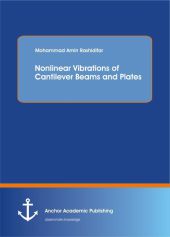 Neuerscheinungen 2015Stand: 2020-02-01 |
Schnellsuche
ISBN/Stichwort/Autor
|
Herderstraße 10
10625 Berlin
Tel.: 030 315 714 16
Fax 030 315 714 14
info@buchspektrum.de |

Mohammad Amin Rashidifar
Nonlinear Vibrations of Cantilever Beams and Plates
Erstauflage. 2015. 148 S. 220 mm
Verlag/Jahr: ANCHOR ACADEMIC PUBLISHING 2015
ISBN: 3-9548942-0-3 (3954894203)
Neue ISBN: 978-3-9548942-0-8 (9783954894208)
Preis und Lieferzeit: Bitte klicken
Many engineering problems can be solved using a linear approximation. In the Finite Element Analysis (FEA) the set of equations, describing the structural behaviour is then linear K d = F (1.1) In this matrix equation, K is the stiffness matrix of the structure, d is the nodal displacements vector and F is the external nodal force vector. Characteristics of linear problems is that - the displacements are proportional to the loads, - the stiffness of the structure is independent on the value of the load level. Though behaviour of real structures is nonlinear, e.g. displacements are not proportional to the loads; nonlinearities are usually unimportant and may be neglected in most practical problems.
Text Sample:
Chapter 1.1 Motivation:
The beam is one of the fundamental elements of an engineering structure. It finds use in varied;structural applications. Moreover, structures like helicopter rotor blades, spacecraft antennae, flexible;satellites, airplane wings, gun barrels, robot arms, high-rise buildings, long-span bridges, and subsystems;of more complex structures can be modeled as a beam-like slender member. Therefore, studying;the static and dynamic response, both theoretically and experimentally, of this simple structural component;under various loading conditions would help in understanding and explaining the behavior of;more complex, real structures under similar loading.;Interesting physical phenomena occur in structures in the presence of nonlinearities, which cannot;be explained by linear models. These phenomena include jumps, saturation, subharmonic, superharmonic,;and combination resonances, self-excited oscillations, modal interactions, and chaos. In reality,;no physical system is strictly linear and hence linear models of physical systems have limitations of;their own. In general, linear models are applicable only in a very restrictive domain like when the;vibration amplitude is very small. Thus, to accurately identify and understand the dynamic behavior;of a structural system under general loading conditions, it is essential that nonlinearities present in the;system also be modeled and studied.;In continuous (or distributed-parameter) systems like structures, nonlinearities essentially couple;;the linearly uncoupled normal modes, and this coupling could lead to modal interactions (i.e., interaction;between the modes), resulting in the transfer of energy among modes. Experiments have;demonstrated that sometimes energy is transferred from a directly excited high-frequency mode to a;low-frequency mode, which may be extremely dangerous because the response amplitude of the lowfrequency;mode can be very large compared with that of the directly excited high-frequency mode. A;lot of research is under way to understand this and other interesting nonlinear phenomena.;In this dissertation, we study both experimentally and theoretically the nonlinear vibrations of two;flexible, metallic cantilever beams under transverse (or external or additive) harmonic excitations. In;particular, we investigate the transfer of energy between modes whose natural frequencies are widely;spaced - in the absence and presence of an internal resonance. We also develop an experimental;parametric identification technique to estimate the linear and nonlinear damping coefficients of a beam;along with its effective nonlinearity. In addition, we study experimentally the response of a rectangular,;metallic cantilever plate under transverse harmonic excitation.


